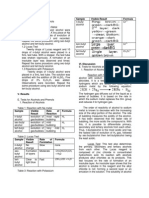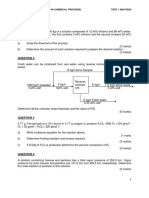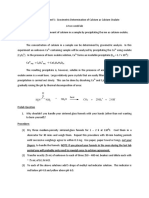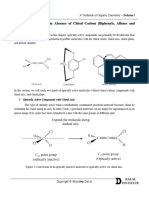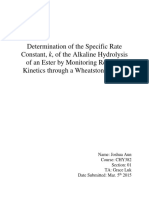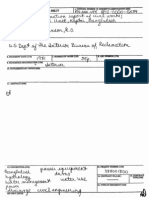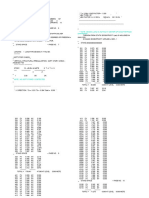Formal Lab
Formal Lab
Uploaded by
ljeanja2Copyright:
Available Formats
Formal Lab
Formal Lab
Uploaded by
ljeanja2Copyright
Available Formats
Share this document
Did you find this document useful?
Is this content inappropriate?
Copyright:
Available Formats
Formal Lab
Formal Lab
Uploaded by
ljeanja2Copyright:
Available Formats
Multistep Synthesis of Phenytoin
The synthesis of phenytoin from benzil, benzoin, and benzaldehyde via reflux and vacuum filtration.
In this laboratory experiment a synthesis was performed through several separate steps. The purpose of the experiment was to synthesize Phenytoin from benzaldehyde through a series of three different synthesis. There was a total of three steps that led up to the synthesis of the final product, Phenytoin. The first step of the experiment yielded benzoin from an condensation of benzaldehyde resulting in a % yield and a melting point of 126-129 degrees celsius. Thiamine catalyst along with water and ethanol were added to the benzaldehyde, then NaOH was added until the solution turned yellow. After recrystallization, the product was benzoin. Step two was the oxidation of benzoin to benzil producing a yield at % and a melting point 83-85 degrees celsius. Nitric acid was added to the benzoin and heated, this was followed by recrystallization to yield the benzil. In step three the benzil from step two was used to synthesize Phenytoin. The benzil and 5,5Diphenylhydantoin were mixed with ethanol. After heating this, ethanoic KOH was added and the solution was left to reflux. The crystals were washed and collected. This ended the multistep synthesis. The final product was not successfully synthesized due to sources of error during procedures. Therefore, a low percent yield of 40.4% was found. The theoretical melting point for Phenytoin 298-305 degrees Celsius.
Introduction: This experiment was designed to synthesize phenytoin through a series of three steps. When synthesizing intricate organic molecules, multiple reaction steps are commonly required. Phenytoin is in the hydantoin class of anticonvulsants. This drug was approved by the FDA in 1953 for the treatment and prevention of seizures. The goal of this experiment is to synthesize phenytoin and providing enough product to perform the next step.
Results and Discussion: During this lab experiment, phenytoin was synthesized from benzil, which was later synthesized from benzoin. Benzoin was the product of a condensation of benzaldehyde. It was found after the condensation of benzaldehyde, the product had a melting point of 126-129 degrees celsius. The melting point of benzoin is stated to range from 132-137 degrees celsius, according to www.chemical1and21.com. The melting point is a little low, but good enough to use for the next step. The oxidation of benzil was extremely impure with a yield of 30%. During the second step, benzoin undergoes oxidation by nitric acid to form benzil. The melting point obtained was 83-85 degree celsius. The melting point of benzil is stated to range from 94-95 degrees celsius, according to www.chemical1and21.com. The melting point is a little low again, but good enough to use for the next step. The oxidation of benzoin was extremely pure with a yield of 123%. Benzoin was used in the final step with a melting point of 298-305 degrees celsius obtained and a yield of 40.4%. The melting point obtained indicated that the solution was pure, based off the true melting point of phenytoin of 295-298 degrees celsius according to www.chemical1and21.com. Some possible sources of error include loss of product while transferring from flask to flask causing some of the product to fall on lab desk and loss of product while vacuum filtration. Another source of error is not properly washing items used for lab. For example, I noticed that there may have been some soap residue left in my graduated cylinder causing the products to be impure.
Experimental: Benzoin Benzoin was synthesized through an condensation of benzaldehyde. Benzaldehyde (7.5 ml, 7.81125g, 0.074 mols), 95% ethanol (15.0 ml, 0.257 mols), sodium hydroxide (2.5 ml, 0.133 mols) were placed in a round bottom flask along with a dissolved thiamine (1.3 g, 0.004 mols) and water (4.0 ml).
The solution was placed in a ice cold bath until solid formed. Once solid formed, the mixture was filtrated via vacuum filtration and place to dry. Once dried, the weight and melting point were obtained.
Benzil In order to synthesize benzil, an oxidation reaction of benzoin occurs. In a round-bottom flask, concentrated nitric acid (14 ml) was added to benzoin (4.0g, 0.018 mols) and heated for thirty minutes. After five minutes, we began aspirating the nitrogen oxide from the flask using a vacuum tube. The resulting solution was poured into a beaker containing water (75 ml) and filtrated via vacuum filtration. The dried product was recrystallized using 95% ethanol and filtered again. Once dried, the weight and melting point were obtained.
Phenytoin Phenytoin was synthesized from a reaction of benzil. Flask #1 consisted of benzil (2.0g, 0.010 mols), urea (0.96g, 0.015 mols) , and ethanol (50 ml). Flask #2 consisted of sodium hydroxide pellets (1.8g) and water (6 ml). Once both solutions dissolved, flask #2 was added to flask #1. The new mixture was refluxed for an hour. After reflux, the mixture was cooled using a wet paper towel. Water (25 ml) was added after mixture was cool; slowly acidified the filtrate with concentrated hydrochloric acid. The mix was now ready to be filtrated via vacuum filtration. The dried product was recrystallized using 95% ethanol and filtered again. Once dried, the weight and melting point were obtained.
References: 1. www.chemicalbook.com 2. www.chemical1and21.com
The synthesis of phenytoin from benzil, benzoin, and benzaldehyde via reflux and vacuum filtration.
Linda Jean-Jacques Organic Chemistry II November 17, 2011
You might also like
- 28 Ton Grove RT528CDocument8 pages28 Ton Grove RT528CLeo Villa100% (4)
- Full Report Exer 1Document8 pagesFull Report Exer 1marinella100% (1)
- Exp1 Sic180033 PDFDocument6 pagesExp1 Sic180033 PDFfara basar100% (1)
- Gravimetric Determination of Moisture CoDocument5 pagesGravimetric Determination of Moisture CoDEFIN BIMA REYNANDANo ratings yet
- Experiment 5 Determination of Caffeine 2020Document4 pagesExperiment 5 Determination of Caffeine 2020FYNo ratings yet
- A09 010A Determination of Caffeine in Beverages Using UV Wavelength SpectrosDocument3 pagesA09 010A Determination of Caffeine in Beverages Using UV Wavelength SpectrosdedicmirzaNo ratings yet
- S171E P3 Modbus Protocol Manual V1 0A 04 2007Document96 pagesS171E P3 Modbus Protocol Manual V1 0A 04 2007Anurag ChopraNo ratings yet
- Fiitjee Phase Test PaperDocument21 pagesFiitjee Phase Test PaperPUBG INDIA FAN CLUB100% (4)
- CC Y C" #$ %&'' (!') ' +Document11 pagesCC Y C" #$ %&'' (!') ' +pinky_marian17100% (3)
- Diesel Generator TroubleshootingDocument7 pagesDiesel Generator TroubleshootingChandra Vinoth Senthilnathan100% (4)
- Experiment 3 - Bromination of AcetoneDocument12 pagesExperiment 3 - Bromination of AcetoneOsama AnatyNo ratings yet
- Atr Ft-Ir Imaging of Acetic AcidDocument10 pagesAtr Ft-Ir Imaging of Acetic AcidMon RonquilloNo ratings yet
- Soduim Borohydride Reduction of CyclohexanoneDocument10 pagesSoduim Borohydride Reduction of CyclohexanoneAlohaaSwezzNo ratings yet
- Cis Trans Isomerism Maleic AcidDocument5 pagesCis Trans Isomerism Maleic Acidsachin0002No ratings yet
- Sodium Borohydride Reduction of CyclohexanoneDocument6 pagesSodium Borohydride Reduction of CyclohexanoneMohd Nakirudin Muhamad Nor100% (6)
- Determination of S As Barium SulfateDocument7 pagesDetermination of S As Barium SulfateRon AguilarNo ratings yet
- Robinson Annulation Reaction of NItrochalconeDocument10 pagesRobinson Annulation Reaction of NItrochalconeMohd Nakirudin Muhamad NorNo ratings yet
- Objectives: FIGURE A: Example of Coordination CompoundsDocument7 pagesObjectives: FIGURE A: Example of Coordination CompoundsNurul izzatiNo ratings yet
- Lab 4Document8 pagesLab 4NelvianaNo ratings yet
- Qualitative Analysis Formal Report - AlcoholsDocument3 pagesQualitative Analysis Formal Report - AlcoholsPrincess Alyssa Abid100% (1)
- Example of Lab ReportDocument15 pagesExample of Lab ReportElouisa OlaybalNo ratings yet
- Determination of Partition Coefficient of A Substance Between Two Immiscible LiquidsDocument3 pagesDetermination of Partition Coefficient of A Substance Between Two Immiscible Liquidsjaveria namoos100% (1)
- Nitrating Methyl BenzoateDocument6 pagesNitrating Methyl BenzoateOstap 奧斯塔普67% (3)
- Absorption Spectrum of A Conjugated DyeDocument6 pagesAbsorption Spectrum of A Conjugated DyeKing Everest100% (1)
- Beckmann Rearrangement Cyclohexanone Oxime and Its Rearrangement to Ε-CaprolactamDocument4 pagesBeckmann Rearrangement Cyclohexanone Oxime and Its Rearrangement to Ε-CaprolactamElif YeşilyaprakNo ratings yet
- Answer All Questions.: Cmt405 (Unit Operation in Chemical Process) TEST 1 MAY2020Document3 pagesAnswer All Questions.: Cmt405 (Unit Operation in Chemical Process) TEST 1 MAY2020Nasuha AriffinNo ratings yet
- ALDOL Synth - DibenzalacetoneDocument7 pagesALDOL Synth - DibenzalacetoneJames CookeNo ratings yet
- Abstract (Lab 2) Ionization ConstantDocument12 pagesAbstract (Lab 2) Ionization Constantmirdza94No ratings yet
- Preparation of Acetaline Notes PDFDocument6 pagesPreparation of Acetaline Notes PDFAnonymous Wwxatt3oIK100% (1)
- Liquid Liquid ExtractionDocument36 pagesLiquid Liquid ExtractionamirnimoNo ratings yet
- CHM 212 Experiment 5 - Gravimetric Determination of Calcium As ...Document2 pagesCHM 212 Experiment 5 - Gravimetric Determination of Calcium As ...Shante MorganNo ratings yet
- OCHII Week 3 - Practical Assessment 2Document3 pagesOCHII Week 3 - Practical Assessment 2Gwen Gina XoaxNo ratings yet
- Gravimetric Determination of Moisture and Phosphorus Content in Fertilizer SamplesDocument8 pagesGravimetric Determination of Moisture and Phosphorus Content in Fertilizer SamplesanaperturescienceNo ratings yet
- ATOOCV1!2!13 Optical Activity in Absence of Chiral Carbon Biphenyls Allenes and SpiranesDocument13 pagesATOOCV1!2!13 Optical Activity in Absence of Chiral Carbon Biphenyls Allenes and Spiranesvanshkhurana8077No ratings yet
- Title: Preparation of 4-MethylcyclohexeneDocument7 pagesTitle: Preparation of 4-MethylcyclohexeneNur AthirahNo ratings yet
- CHM 421 Exp 3Document6 pagesCHM 421 Exp 3EmmiliaNo ratings yet
- 2211 - Benzil From BenzoinDocument7 pages2211 - Benzil From Benzoindubstepo0% (1)
- CHM256 - Tutorial 5Document2 pagesCHM256 - Tutorial 5Fatimah Azzahrah0% (1)
- Chm580 Experiment 3Document9 pagesChm580 Experiment 3ohhiNo ratings yet
- CHY382-01 Ester Hydrolysis Lab ReportDocument5 pagesCHY382-01 Ester Hydrolysis Lab ReportJoshua AunNo ratings yet
- LAB LLE FULL REPORT ZkinDocument26 pagesLAB LLE FULL REPORT ZkinAmir Al-AimanNo ratings yet
- Qualitative Analysis: Identification of The AnionDocument40 pagesQualitative Analysis: Identification of The AniontwinkledreampoppiesNo ratings yet
- Chemical KineticsDocument2 pagesChemical KineticsSyaRifah SyazwAnieNo ratings yet
- chm510 Exp2Document10 pageschm510 Exp2May LeeNo ratings yet
- UTAR Chem Lab 1 Full Report Exp12Document7 pagesUTAR Chem Lab 1 Full Report Exp12Izykiel EdwardNo ratings yet
- CE - Experiment 2 Extraction With Acid and AlkalineDocument8 pagesCE - Experiment 2 Extraction With Acid and AlkalineWeiChingNo ratings yet
- A. Experiment Title: The Making of N-Butyl Acetate B. Experiment Started Date: Wednesday, March 4Document21 pagesA. Experiment Title: The Making of N-Butyl Acetate B. Experiment Started Date: Wednesday, March 4Era MelaniaNo ratings yet
- Lab Report chm457 Exp 3Document3 pagesLab Report chm457 Exp 3pufff witchesNo ratings yet
- CHE 331 Past Term Paper AnswersDocument5 pagesCHE 331 Past Term Paper AnswersKatlo KoketsoNo ratings yet
- Lab ReportDocument9 pagesLab ReportmawarNo ratings yet
- Chemistry 12 - Unknown Acid Base Titration LabDocument6 pagesChemistry 12 - Unknown Acid Base Titration LabarasurtNo ratings yet
- Saliva ReportDocument11 pagesSaliva Reportgrace meunierNo ratings yet
- Ochem 13Document2 pagesOchem 13IzzyNo ratings yet
- Lab CHM 457 Exp 2Document10 pagesLab CHM 457 Exp 2JohanNo ratings yet
- Exercise 1 Answer To Quide QuestionsDocument3 pagesExercise 1 Answer To Quide QuestionsrickyNo ratings yet
- Viscosity Average Molecular WeightDocument2 pagesViscosity Average Molecular WeightASHNA RAJUNo ratings yet
- Determination of Specific Rotation of LactoseDocument6 pagesDetermination of Specific Rotation of LactoseMatthew VillanuevaNo ratings yet
- L2 Viscosity ExperimentDocument2 pagesL2 Viscosity ExperimentHussam AshourNo ratings yet
- 4d Application of Complexometric TitrationDocument16 pages4d Application of Complexometric TitrationnajwaNo ratings yet
- Determination of Chloride by Volhard and Mohr MethodDocument6 pagesDetermination of Chloride by Volhard and Mohr MethodShane AmolarNo ratings yet
- Lab Report GCDocument8 pagesLab Report GCAyish MataNo ratings yet
- Lab1 3Document5 pagesLab1 3Izzat Arif33% (3)
- Recrystallization Lab Report FinalDocument6 pagesRecrystallization Lab Report Finalapi-255889385No ratings yet
- Multi Step Synthesis Post LabDocument23 pagesMulti Step Synthesis Post LabmahiujahangirNo ratings yet
- Wittig Reaction ReportDocument3 pagesWittig Reaction ReportjohnjohnrocksNo ratings yet
- Advantages S7-1200 To S7-200Document35 pagesAdvantages S7-1200 To S7-200Jesus CayoNo ratings yet
- Ghasemi and BasuDocument11 pagesGhasemi and BasuPreethiNo ratings yet
- Technical Test - 01 FinalDocument16 pagesTechnical Test - 01 FinalVamshiNo ratings yet
- Building in Slope SiteDocument55 pagesBuilding in Slope SitePopcathrobyNo ratings yet
- Perhitungan Box GirderDocument37 pagesPerhitungan Box GirderBambang Wahyu Widayat100% (1)
- Clausius BookDocument430 pagesClausius Bookbanedog100% (1)
- Prakhar Patwari CVDocument3 pagesPrakhar Patwari CVshivanshvr16No ratings yet
- MTAVC-0 2 0-ManualDocument6 pagesMTAVC-0 2 0-ManualStephanie CurryNo ratings yet
- MXT224 Datasheet FX 1 5Document46 pagesMXT224 Datasheet FX 1 5Nick GartNo ratings yet
- Examination Report - SH DamDocument59 pagesExamination Report - SH DamsarvannnNo ratings yet
- Valve Cross SectionDocument1 pageValve Cross SectionJaya PrakashNo ratings yet
- Cryptology: Plaintext - Is The Message Before It Was CodedDocument3 pagesCryptology: Plaintext - Is The Message Before It Was CodedKyla Marie PlazaNo ratings yet
- Nomex Tape410 TechnicaldatasheetDocument7 pagesNomex Tape410 TechnicaldatasheetAdrian LeeNo ratings yet
- 1848 N. Lincoln Ave. Opposition LettersDocument17 pages1848 N. Lincoln Ave. Opposition LettersKelly BauerNo ratings yet
- SPE-37054-MS (Bit Torque Calculation) PDFDocument9 pagesSPE-37054-MS (Bit Torque Calculation) PDFWindy MartdianzahNo ratings yet
- JSA UT Thickness PVDocument3 pagesJSA UT Thickness PVMuhammadHudanulHakim67% (3)
- Bank Protection: Reference ManualDocument45 pagesBank Protection: Reference ManualSwopnil KalikaNo ratings yet
- Construction and Operation of Megger ExplainedDocument10 pagesConstruction and Operation of Megger ExplainedAratrika GhoshNo ratings yet
- AfafDocument10 pagesAfafDavis Chad MagalongNo ratings yet
- An Introduction To Arp Spoofing Sean WhalenDocument7 pagesAn Introduction To Arp Spoofing Sean Whalenlsdn1No ratings yet
- Earthquake Detector Alarm Using ArduinoDocument9 pagesEarthquake Detector Alarm Using ArduinoMxolisi MtnNo ratings yet
- Brochure OLU 20160224 EN - CompressedDocument48 pagesBrochure OLU 20160224 EN - CompressedAlaa saidNo ratings yet
- Features:: Protection Relays Closed Toroid For Residual Current ProtectionDocument1 pageFeatures:: Protection Relays Closed Toroid For Residual Current Protectionvinay kumarNo ratings yet
- Promica IC3A ManualDocument19 pagesPromica IC3A Manualpinoyblood71No ratings yet
- RX50 EN 02-2018 Manual Web PDFDocument398 pagesRX50 EN 02-2018 Manual Web PDFCriistinna MihhNo ratings yet



















